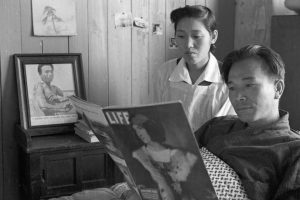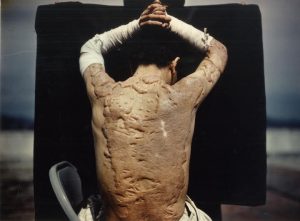Documenting Hiroshima 80 years after A-bombing: Around September 1947, “Atomic Bomb Victim No. 1” reveals scars to US photographic magazine, calls for peace
Jan. 30, 2025
by Kyosuke Mizukawa, Senior Staff Writer
Around September 1947, Kiyoshi Kikkawa and his wife, Ikimi, were staying for an extended period at the Hiroshima Red Cross Hospital (in Hiroshima City’s present-day Naka Ward). Mr. Kikkawa had been hospitalized after suffering from keloids, or raised skin lesions, due to severe burns on his back and arms from the atomic bombing he had experienced at the age of 33. The world-renowned, U.S. photographic magazine Life published several images of him in its September 1, 1947, issue.
According to his book Genbaku Ichigo to Iwarete (in English, “I was called ‘Atomic Bomb Victim No. 1’”), published in 1981, after finishing the night shift as a security guard for Hiroshima Electric Railway on August 6, 1945, Mr. Kikkawa had returned to his home in the area of Hakushima Nishinaka-machi (in Hiroshima’s present-day Naka Ward), around 1.5 kilometers from the hypocenter. Just as he entered the front door, he experienced “an intense light, as if a bright red sun had exploded above my head.” He was then hit with a powerful, hot blast and a deafening roar.
Mr. Kikkawa crawled out from under his collapsed house, helped his wife, and they both ran to escape from the approaching flames. “Ashy skin from my shoulders to both arms hung like tattered rags,” he wrote. He was cared for at a temple on the outskirts of Hiroshima for more than two months, after which he stayed with relatives in the northern part of Hiroshima Prefecture. “Once-closed wounds reopened, oozing yellow pus and blood.” Introduced by the Hiroshima Prefectural government, Mr. Kikkawa was admitted to the Hiroshima Red Cross Hospital in March 1946.
In April 1947, when about one year had passed without signs of recovery, Fumio Shigeto, an assistant director at the hospital, asked him for an unexpected favor. He explained that about 20 military officials and print journalists from the United States would be visiting to take a look at the hospital, and that they were interested in taking photographs of Mr. Kikkawa and listen to his story.
g>“Give me back my body” g>
At first, he firmly refused. “I will not let the people who created hell on earth make a show of me,” he explained. Gradually, however, Mr. Kikkawa’s feelings changed. Although he was still angry, he came to realize that “it would be a perfect opportunity to make a direct appeal to the people of the country that inflicted such damage about how cruel the atomic bombing was.”
In a hospital room that had been prepared for the photo shoot, he took off his hospital gown, revealing the keloids on his upper body. Showered with the flashes of cameras, Mr. Kikkawa was seized with a sense of humiliation, anger, and grief, and cried out to himself, “Give me back my body as it was before; return me to how I was.”
He had also agreed to an interview, at which he conveyed that he would be willing to be sent to the United States to undergo testing by scientists if his body could serve as a “foundation of peace for humankind.” Mr. Kikkawa’s willingness to visit the United States and photographs of him at that time were introduced in the September 1 issue of Life magazine under the heading, “A survivor hopes his wounds will serve peace.”
During the interview, someone in the group of journalists is said to have called him the first “atomic bomb patient” in English. With that, Mr. Kikkawa became known in Japan as “Genbaku Ichigo” (in English, “Atomic Bomb Victim No. 1”), after which he began receiving repeated interview requests from both Japan and overseas.
g>No government relief for A-bomb victims g>
Meanwhile, with the keloids causing him great pain, Mr. Kikkawa underwent repeated skin grafts. He sold a “small piece of property” and mountain forest land that he owned, using the money to purchase food. At that time, there was no relief available for A-bomb survivors from Japan’s national government.
According to his book, Mr. Kikkawa was discharged by the hospital in April 1951 with no job and no place to live. On the advice of an acquaintance, he opened a small souvenir shop next to the Hiroshima Prefectural Industrial Promotion Hall (present-day A-bomb Dome). He also began organizing those who had suffered from the bombing, an effort he had planned while in the hospital.
(Originally published on January 30, 2025)
Around September 1947, Kiyoshi Kikkawa and his wife, Ikimi, were staying for an extended period at the Hiroshima Red Cross Hospital (in Hiroshima City’s present-day Naka Ward). Mr. Kikkawa had been hospitalized after suffering from keloids, or raised skin lesions, due to severe burns on his back and arms from the atomic bombing he had experienced at the age of 33. The world-renowned, U.S. photographic magazine Life published several images of him in its September 1, 1947, issue.
According to his book Genbaku Ichigo to Iwarete (in English, “I was called ‘Atomic Bomb Victim No. 1’”), published in 1981, after finishing the night shift as a security guard for Hiroshima Electric Railway on August 6, 1945, Mr. Kikkawa had returned to his home in the area of Hakushima Nishinaka-machi (in Hiroshima’s present-day Naka Ward), around 1.5 kilometers from the hypocenter. Just as he entered the front door, he experienced “an intense light, as if a bright red sun had exploded above my head.” He was then hit with a powerful, hot blast and a deafening roar.
Mr. Kikkawa crawled out from under his collapsed house, helped his wife, and they both ran to escape from the approaching flames. “Ashy skin from my shoulders to both arms hung like tattered rags,” he wrote. He was cared for at a temple on the outskirts of Hiroshima for more than two months, after which he stayed with relatives in the northern part of Hiroshima Prefecture. “Once-closed wounds reopened, oozing yellow pus and blood.” Introduced by the Hiroshima Prefectural government, Mr. Kikkawa was admitted to the Hiroshima Red Cross Hospital in March 1946.
In April 1947, when about one year had passed without signs of recovery, Fumio Shigeto, an assistant director at the hospital, asked him for an unexpected favor. He explained that about 20 military officials and print journalists from the United States would be visiting to take a look at the hospital, and that they were interested in taking photographs of Mr. Kikkawa and listen to his story.
At first, he firmly refused. “I will not let the people who created hell on earth make a show of me,” he explained. Gradually, however, Mr. Kikkawa’s feelings changed. Although he was still angry, he came to realize that “it would be a perfect opportunity to make a direct appeal to the people of the country that inflicted such damage about how cruel the atomic bombing was.”
In a hospital room that had been prepared for the photo shoot, he took off his hospital gown, revealing the keloids on his upper body. Showered with the flashes of cameras, Mr. Kikkawa was seized with a sense of humiliation, anger, and grief, and cried out to himself, “Give me back my body as it was before; return me to how I was.”
He had also agreed to an interview, at which he conveyed that he would be willing to be sent to the United States to undergo testing by scientists if his body could serve as a “foundation of peace for humankind.” Mr. Kikkawa’s willingness to visit the United States and photographs of him at that time were introduced in the September 1 issue of Life magazine under the heading, “A survivor hopes his wounds will serve peace.”
During the interview, someone in the group of journalists is said to have called him the first “atomic bomb patient” in English. With that, Mr. Kikkawa became known in Japan as “Genbaku Ichigo” (in English, “Atomic Bomb Victim No. 1”), after which he began receiving repeated interview requests from both Japan and overseas.
Meanwhile, with the keloids causing him great pain, Mr. Kikkawa underwent repeated skin grafts. He sold a “small piece of property” and mountain forest land that he owned, using the money to purchase food. At that time, there was no relief available for A-bomb survivors from Japan’s national government.
According to his book, Mr. Kikkawa was discharged by the hospital in April 1951 with no job and no place to live. On the advice of an acquaintance, he opened a small souvenir shop next to the Hiroshima Prefectural Industrial Promotion Hall (present-day A-bomb Dome). He also began organizing those who had suffered from the bombing, an effort he had planned while in the hospital.
(Originally published on January 30, 2025)









